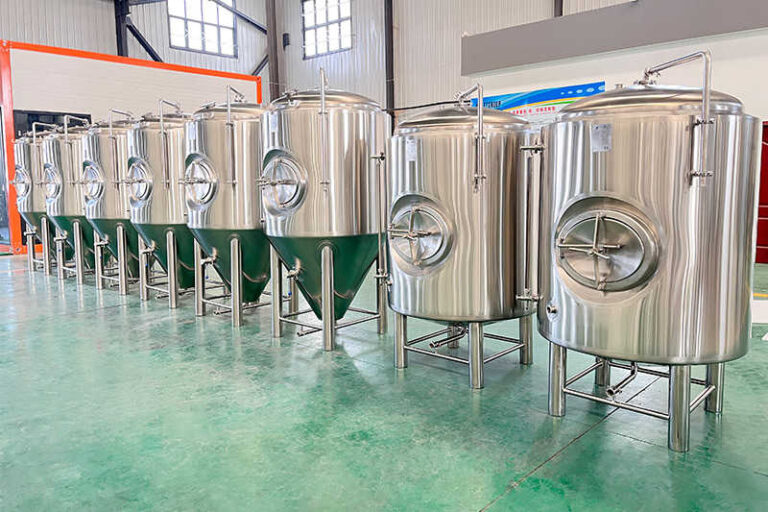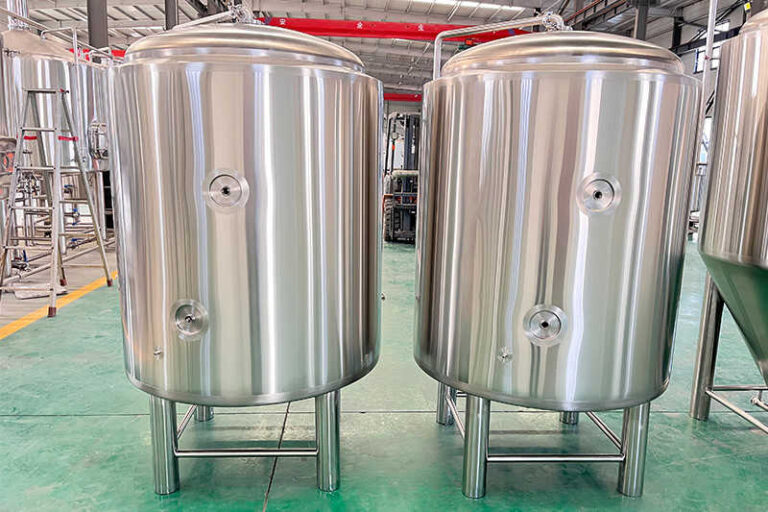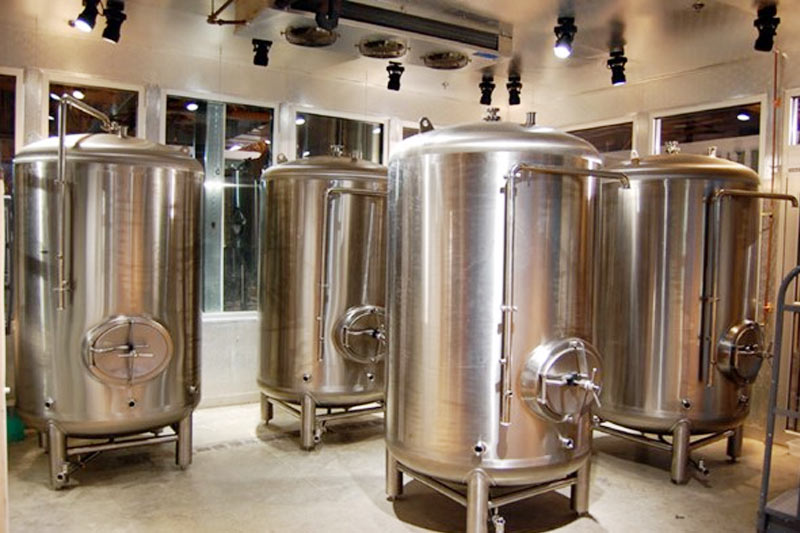In the beer brewing process, the bright tank (BBT for short) is a key equipment, usually located in the final stage after fermentation and before packaging. It has a direct impact on the quality of beer, especially in beer. Bright tanks not only help beer improve the fermentation and sediment of beer, but also provide an ideal environment for beer, promote the maturation of the body, and ensure the taste of the beer. This article will deeply explore the role of bright tanks in the beer brewing process to improve the overall quality and production efficiency of beer.
What is a bright tank?
A bright tank (BBT) is a stainless steel container used to store and handle beer that has been preliminarily fermented, carbonated, and stored. Bright tanks are also called service tanks, storage tanks, etc. These tanks usually have a pressure rating and can be equipped with accessories that allow safe pressure transmission. Therefore, the beer stored in the bright tank is clear and can be drunk directly.
Functions of bright tanks:
- Clarification function: During the pre-fermentation of beer, yeast, protein, and other suspended matter will enter the body of the beer, affecting the appearance of the beer. The bright tank provides a low temperature and low-pressure environment, which is conducive to the precipitation of suspended matter in the beer to the bottom so that the body of the beer becomes clearer and more transparent.
- Secondary fermentation and flavor improvement: Bright tanks are usually used in the secondary fermentation stage of beer, where the beer continues to convert the remaining sugar into alcohol and ferment. This process is not only conducive to reducing the sugar content in the beer but also further improves the taste of the beer, making the body more rounded and the flavor richer.
- Carbonation: An important function of the bright container is the controlled carbonation process of beer. At this stage, the bubbles in the beer are dissolved into the body of the wine, and by pressurizing or using the input of external bubbles, the beer is guaranteed to have an ideal sense of bubbles, which enhances the visual effect and pre-experience of the beer.
- Maturation and stability: The bright tank provides a stable temperature and pressure environment for the wine body, which is conducive to the maturation of the wine body. In this process, the beer and beer in the beer are further developed, the smell of the wine body becomes stronger, more balanced, and stable, and the aroma is more lasting.

Structure and design of bright tanks
- Pressure vessel: Bright tanks can withstand a certain internal pressure and can usually work in a pressure range of 2 to 3 bars. This pressure is conducive to the carbonation process of beer, ensuring that the inflation can be effectively dissolved in the beer, thereby enhancing the foam and taste of the beer.
- Temperature control system: To ensure that the beer can achieve optimal fermentation during the maturation process, the bright tank is usually equipped with a temperature control system. For the key temperature control of beer maturation, clarification, and secondary fermentation, it can effectively prevent excessive or low temperatures from affecting the brewing process.
- Degassing valve and liquid pipeline: Since a certain amount of gas may be produced during the secondary fermentation process, bright tanks are usually designed with degassing valves to prevent excessive accumulation of gas and ensure the smooth progress of fermentation. In addition, the pipeline used for beer liquid is for transfer, sampling, and discharge.
- Collection port: There is usually a collection port on the bright container to facilitate brewers to monitor the quality during beer storage. Through regular collection, brewers can check the dosage, taste, and carbonation level of beer to ensure that the beer meets the standards.
The role of bright tanks
Achieving clarification and removing sediment
One of the main functions of a clear tank is to promote beer clarification. During the maturation process, yeast and other particles settle to the bottom of the tank. The clear beer is then transferred to the clear tank and any remaining impurities are further precipitated, resulting in a clearer and more visually appealing final product. This process is often referred to as “clarification” or “resting”. During this process, the beer gradually clarifies and the clarity is amplified, giving the beer a transparent, shiny appearance in the end. For most types of beer, clarity is an important criterion for beer quality, so this function of the bright tank is crucial to the appearance of the final beer.
Secondary fermentation and flavor improvement
Secondary fermentation refers to the second fermentation process of beer in a bright tank. During this process, yeast continues to break down the residual sugars in the beer, producing alcohol and fermentation. Although the primary fermentation is complete, the secondary fermentation is still able to affect the flavor and taste of the beer.
The bright tank can provide a stable environment, keeping the temperature and pressure constant, and making the secondary fermentation process smoother and more efficient. This not only helps to further increase the sugar content but also helps the beer to better respond to other ingredients in the beer, making the beer taste richer and more layered. By carrying out proper secondary fermentation in bright tanks, the flavor of the beer will be more balanced and stable.
Temperature and Pressure Control
During the conditioning stage, it is crucial to maintain precise temperature and pressure conditions. Bright tanks are equipped with cooling jackets that allow brewers to regulate the temperature of the beer, ensuring that the beer is kept at the optimal conditioning level. This temperature control also helps prevent off-flavors and maintain the intended flavor of the beer. In addition, bright tanks are designed to withstand pressure, allowing for controlled carbonation. This feature ensures that the beer reaches the desired level of foaming without the risk of over-carbonation, which can cause quality issues.
Flavor Stability and Maturation

FAQ
What is a bright tank?
A bright tank is a container used to mature and store beer, usually after fermentation. They can help improve the appearance and taste of beer.
Do bright tanks affect the flavor of beer?
Yes, bright tanks can affect the flavor of beer, as at this stage, brewers can add other ingredients (such as additional spices or dry discard hops), and the taste can be optimized by adjusting the carbonation level.
Do all breweries use bright tanks?
Not all breweries use bright tanks. Small or home breweries may skip this step and go straight to packaging. However, large and commercial breweries generally use bright tanks to ensure product stability and quality.
What is the capacity of a bright tank?
The capacity of a bright tank can vary depending on the size of the brewery. It can range from a few thousand liters for small craft breweries to thousands of liters for large industrial breweries. The appropriate capacity is usually selected based on production needs.

